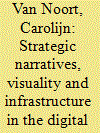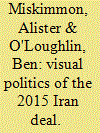|
|
|
Sort Order |
|
|
|
Items / Page
|
|
|
|
|
|
|
| Srl | Item |
| 1 |
ID:
179090


|
|
|
|
|
| Summary/Abstract |
This article engages with the contemporary crisis of American identity and how the narratives of the Trump presidency are visually negotiated in the digital world. The Marvel Comics character Captain America has accompanied American identity constructions, crises, and discourses on US foreign policy for almost 80 years. Thus, it is no surprise that Captain America is again popular at a time of increased national crisis, made ever more present as a core character in the major feature film productions of the Marvel Cinematic Universe. In the digital space, Captain America occupies a crucial political position as an easily identifiable visual carrier of identities and values that correspond with the public’s concerns. This article interrogates how the circulation of visual narratives of Captain America on Twitter and other digital platforms contributes to a broader discourse about the essence of American identity, values and true ‘Americanness’ against the backdrop of a fragmented and polarised nation. While (Captain) America’s search for the truthful narrative remains futile, understanding this futility can help to discover the discursive reasons for the contemporary crisis.
|
|
|
|
|
|
|
|
|
|
|
|
|
|
|
|
| 2 |
ID:
179088


|
|
|
|
|
| Summary/Abstract |
Drawing on the case of Finland and its model of ‘resilience’ to digital disinformation, the article provides an original framework for understanding the logic of digital propaganda and the conditions that may facilitate an effective response. Building on recent research connecting digital propaganda to the disruption of the public spheres in democratic societies, the study argues that the logic of digital propaganda could be unpacked by examining the mechanisms that facilitate the diffusion of disinformation from the microsphere of the daily individual experience to the macrosphere of political decision-making. It is thus argued that the connection between the two spheres is enabled by the formation and political mobilization of ‘unruly’ counterpublics, that is, of arenas of textual and visual contestation of politically marginalized groups promoting issues aligned with the disinformation agenda. Using this framework, the study shows that Finland’s resilience progress has mostly occurred on the macrosphere level, where effective institutions have been applying transparent and proactive policies grounded in collaboration and research. However, these efforts are at risk of being weakened by the rise of influential counterpublics unless Finland takes further measures to protect its public sphere by reducing divisions in the microsphere.
|
|
|
|
|
|
|
|
|
|
|
|
|
|
|
|
| 3 |
ID:
179091


|
|
|
|
|
| Summary/Abstract |
Recent scholarship claims that narratives and images of war have political effects, not simply because of their content and ‘form’, but because of their affective and emotional ‘forces’. Yet, International Relations scholars rarely explore how audiences respond to narratives and images of war in their research. Addressing this gap, this paper combines discourse analysis of RT (formerly Russia Today) ‘breaking news’ YouTube videos of Russian military intervention in Syria with analysis of 750 comments and social media interactions on those videos. Our findings demonstrate how RT layers moral and legal justifications for Russian intervention in multiple audio-visual formats, within a visual narrative of the conflict that relies on affective representations of key actors and events. Viewers largely approve of the content, replicate its core narratives and express emotions coherent with RT’s affective representation of the Syrian conflict. Audiences’ responses to these narratives and images of war were shaped by their affective investments in the identities and events portrayed on-screen. These affective investments are therefore crucial in understanding the political significance of images of armed conflict.
|
|
|
|
|
|
|
|
|
|
|
|
|
|
|
|
| 4 |
ID:
179089


|
|
|
|
|
| Summary/Abstract |
This article explores how propaganda can be used to construct counter-factual visual narratives at times of war. Specifically, it examines how the Islamic State communicated its way through the 100-day-long battle for east Mosul, which was launched by the coalition and its allies in October 2016. Drawing on Jacques Ellul’s 1962 theory of propaganda, it uses qualitative content analysis to decipher the 1,261 media products published online by the group during the first phase of its defence of the city. The author contends that, even though it was resoundingly defeated there by January, the global legacy of this battle, which was used as a testing ground for a series of potent innovations in insurgent strategic communication, will endure long into the future.
|
|
|
|
|
|
|
|
|
|
|
|
|
|
|
|
| 5 |
ID:
179095


|
|
|
|
|
| Summary/Abstract |
Covid-19 is the latest blow to the ailing liberal international order, which has faced a series of challenges in the postwar era. This article traces the global spread of the virus scaled to population and case fatality rates of different countries. Using inferential statistics, I find that liberal democracies have higher case fatality rates than other regime types and offer some plausible explanations for why. Systemically, I show how the spread of the virus complicates the implementation of policies consistent with liberal international order, potentially destroying the order in which liberal democracies participate. Given the paucity of the data as well as cross-country reporting differences in a still evolving crisis, these findings provide a first social scientific cut over the first half year of the pandemic rather than a final assessment of its consequences.
|
|
|
|
|
|
|
|
|
|
|
|
|
|
|
|
| 6 |
ID:
179092


|
|
|
|
|
| Summary/Abstract |
Visual communication is at the heart of international relations in the digital age. Using a range of media tools, political elites communicate so-called ‘strategic narratives’ to persuade and influence the behaviour of target audiences. The existing body of research on ‘strategic narratives’ examines both spoken and written messages. While an academic focus on visual texts is emerging, limited attention has been given to the visualization of peaceful topics such as infrastructure projects. This paper examines the ontological and methodological foundations of ‘strategic narratives’, ‘visuality’, and ‘infrastructure’, to ascertain what seeing strategic narratives on infrastructure means in the study of global politics. The theoretical claims are demonstrated using the case study of China’s Maritime Silk Road Initiative. Herein, it is shown how China communicates strategic narratives on infrastructure to persuade target audiences of its foreign policy priorities, and to secure its self-concept. This communication process is supported by images in the digital sphere.
|
|
|
|
|
|
|
|
|
|
|
|
|
|
|
|
| 7 |
ID:
179087


|
|
|
|
|
| Summary/Abstract |
Social media are inherently visual platforms. Every day, billions of photographs, videos, cartoons, memes, gifs, and infographics are uploaded and shared for the world to see online. As a result, political actors such as diplomats, militaries, international organisations, terrorist groups, corporations, celebrities, diasporas and members of the general public are now visual narrators of global politics. They tell stories about themselves, each other, and the rest of the world through the images they share on social media. Consequently, it is imperative that scholars of International Relations analyse visual narratives of global politics in the digital age. This article introduces the special issue on this topic by drawing together and advancing research on narratives, visual global politics, and digital media. In doing so we outline the conceptual underpinnings of, and rationale for, the special issue before introducing the contributions of each of the articles collected herein.
|
|
|
|
|
|
|
|
|
|
|
|
|
|
|
|
| 8 |
ID:
179094


|
|
|
|
|
| Summary/Abstract |
This article explores the role of visuality and narrative in the forging of the 2015 nuclear deal between Iran and the United Nations Security Council P5 + 1. We advance strategic narrative theory by explaining how narrative alignment between longstanding antagonists can occur through protagonists’ coordination of communication – a methodology of orchestration – across public and private spaces of diplomacy. Analysis of news, policy and social media materials as well as interviews with protagonists allows us to trace the gestures and performances through which actors sought to reinforce or overcome an identity narrative of Iran as untrustworthy and dangerous. We draw on Foucault’s concept of alethurgy to show how verification mechanisms were constructed to ensure Iran’s actions (if not its intentions) could be brought into public view. US and Iranian leaders’ political will was significant, and sanctions and sabotage exerted considerable pressure on Iran. This article demonstrates how communication can enable alignment and peace-making rather than confusion and conflict in world affairs.
|
|
|
|
|
|
|
|
|
|
|
|
|
|
|
|
| 9 |
ID:
179093


|
|
|
|
|
| Summary/Abstract |
Diaspora diplomacy blurs the traditional conceptual dichotomies that map domestic and foreign policymaking efforts. Addressing how such distinctions are varyingly produced requires greater engagement with the way that diplomatic practice modulates the associations between belonging, nation and territory. This paper applies a semiotic analysis to a case study of the images circulated through the social media campaigns of the India Development Foundation of Overseas Indian (IDF-OI) between 2016 and 2017, a quasi-governmental organisation tasked with channelling diaspora philanthropy into state and national social and development projects. It shows that the connotative potential of images simultaneously positioned Indian diasporas as territorial stakeholders within these domestic agendas, whilst also generating performative representations of the diaspora as an extra-territorial global public. It argues that the images circulated through the IDF-OI’s digital platforms legitimised those particular voices that served both ideas, thereby empowering those with existing structural advantages. This paper suggests that with the increased use of social media in diaspora diplomacy, scholarship should engage with the richness of online platforms and the ambiguity of images as a specific component of those spaces, to better understand how diasporas are mobilised as non-state actors in contemporary international political affairs.
|
|
|
|
|
|
|
|
|
|
|
|
|
|
|
|
|
|
|
|
|